WKPP Update, June/July/August 2000
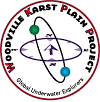

July has been a roller-coaster month of diving for the WKPP, with alternating weeks of significant discoveries and false starts. After adding line at the end of the previous 18000' record line, the lead team of Jarrod Jablonski and George Irvine set out to explore a series of side tunnels for new leads. While the first side tunnels explored were unproductive, one small, siphoning lead in the 14,000 ft area of O-Tunnel and hit the motherlode: "P-Tunnel."
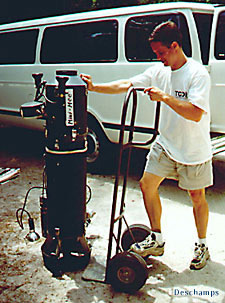
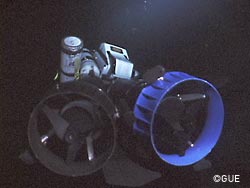
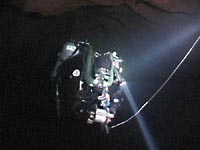
"JJ and I ran from 4500 to 14,000 with four scooters each initially, and then dropped one at 9,000 and one at 14,000. Of the remaining scooters, one had "Mini Mee" attached. Mini is a ten inch long device that snaps onto the end of our scooters with a special nose cone that holds two HID lights and one digital camera pointing out the nose lens. When we hit the end at 14.265, I took Mini Mee and gave JJ my scooter. I looked at the old end and there was a Halcyon patch hanging from the end of the line, which was blowing strongly in the "breeze" of this whipping siphon. The tunnel was extremely small, and I remembered pulling on the rock floor to get out last time due to the heavy flow. The vis was nasty and smoky. JJ tied in and took off into the no floor, no walls, no ceiling room that suddenly appeared out of this little tunnel. We had hit the Mother Lode of cave - bigger than the beginning of Wakulla - in the 120 by 60 range. JJ followed one wall, and at first we thought we were just in a giant room, but the line stayed straight, and he tied off after several hundred feet on one shot, and then swerved to the other wall to be sure it was there, and then back. All the while I was close on him with Mini Mee running the video which produced some great shots."
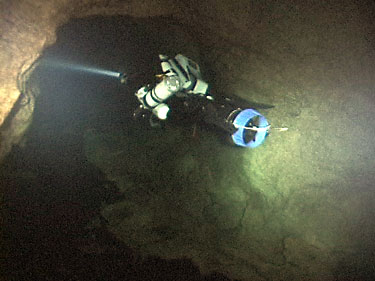
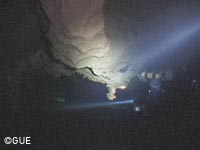
Although timing and conditions would prevent the teams from making significant progress in P-Tunnel on July 15, both the primary and secondary rebreather teams were able to stage equipment into the system that would allow for a big push into P-Tunnel on the 22nd without the need for additional setup.
Nobody knew what to expect when George and JJ left from Wakulla beach at 7:45 am on July 22nd. Just over seven hours later the exploration team was back at the entrance restriction with the bittersweet results: P-Tunnel itself is not the key that unlocks the secret of Wakulla. The video tells the story best: while JJ is concentrating on spooling out line after ducking through a smaller section of tunnel and into a huge void, George begins to flash his light after making an unexpected discovery. After nearly 2,000' of newly explored tunnel, P-Tunnel looped back into O-Tunnel about 200 hundred feet short of the end of the line at 18,000 feet; the team had just scootered a world-record 19,000 feet at depth averaging 250' only to end up on the wrong side of their previous record! The two divers pulled out wet notes discussing the best course of action and can be heard laughing about the silty conditions on the video. The team returned through P-Tunnel to survey for side passages, noting several large areas and a couple very promising leads. The most promising lead starts at 17,000' and heads due north, hopefully continuing toward Leon Sinks.
George Irvine describes the dive:
"Jarrod and I got off before 8:00 am and out of the water by 10:30 p.m. with a fast paced 6 1/2 hour bottom time turnaround and a clean 8.5 hour deco. Thanks to last weekend's setup, we made record time out to 17,000 feet where we started adding line in P-Tunnel. After 2,000 feet of low and wide interspersed with giant rooms and big tunnel, we looped back through a low slot into the end of O Tunnel, going 19,000 feet to get 18,000 feet. We videoed the whole 2000 addition, as well as the cave from 14,000 into 10,000, leaving only a small section to video before we have the entire cave recorded. I videoed JJ adding line, he videod the way out, including finding a giant new lead at 17,000 feet headed NW towards Leon Sinks. This we did not see on the way in as it was beyond a breakdown pile, but JJ was on the left wall coming out and I was on the line, so we got it."
Surface manager David Sweetin gives the details of the day's operation:
"Starting at 6 AM, rebreathers, drive bottles and scooters hit the water, followed immediately by George and JJ, and the now common sight of film and sound crews. Todd Leonard assisted BMA Production's Darren Tedder in capturing the poignant moments on video.
The beach area, although devoid of tourists so early in the morning, was quite popular with 3 of the local gators, who cruised back and forth checking out the action. These 6 footers may just be tough enough to hang with us. Just before hitting the hammer, JJ's final prophetic words: "Looks like a beautiful day for diving." He grinned, apologized and descended.
Doug Lewis, and "The Hardest Working Man in Diving" Jerry Moore, placed the next batch of deco bottles (4500 team and Deco RB team). With all accomplished, we began preparations for the next flurry of activity. Heather Hunsucker, Nanci LeVake and David Lennon were met at the water by Glen Hunt, David Rhea, and Ted Cole carrying deco rebreathers. In typical WKPP style, the sun worshippers on the beach were very curious as divers and equipment appeared, clipped in, and disappeared in less than 15 minutes. The only signs of our presence were a smattering of scooters and tanks, hidden in the weeds, as well as our ever present permit sign (which makes a handy place for bathers to hang wet beach towels).
At about 3:00PM we were remarking how much cooler it was than the previous weekend, when the lightning started. Park rangers cleared the beach and closed the gate. Tree limbs were falling, lightning seemed to be crashing on the other side of the basin, and animals were lining up in pairs! It was at this time that George and JJ were back in our sight and the 4500 team prepared to depart. Besieged by rain, David Rhea, David Lennon and Ed Pellar picked George and JJ clean of their remaining gear, while Herve Deschamps, Scott Hunsucker, Barry Miller, and Ted Cole screamed past on their sortie to 4500. Monitoring the exploration and 4500 teams on their first and second dives at Wakulla were Glen Hunt and Grady Richardson, along with team members mentioned earlier making their second or third set of support dives.
Only in the WKPP can you see 2 guys, 300 feet deep, at 18 grand, on rebreathers, setting up for Spielberg-esque video shots! With a skeleton crew, working literally from sunrise to just after sunset, the WKPP: set up made a world record level penetration video taped it slipped out unnoticed by approximately 2000 tourists IN ONE DAY!!"
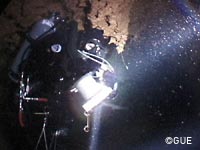 |
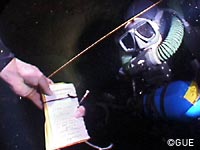 |
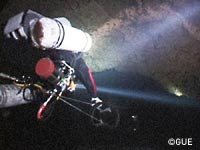 |
Individual Dive Reports for June/July 2000:

